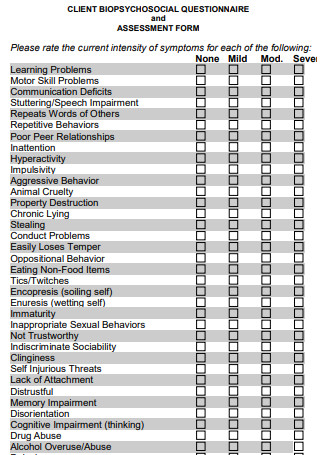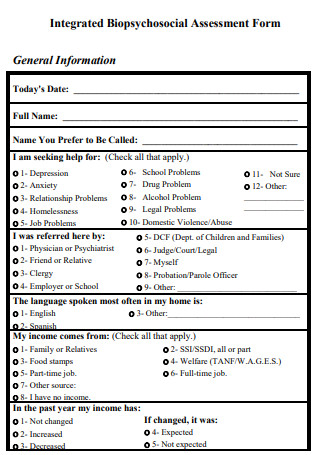3+ SAMPLE Biopsychosocial Assessment Form
FREE Biopsychosocial Assessment Form s to Download
3+ SAMPLE Biopsychosocial Assessment Form
What Is a Biopsychosocial Assessment Form?
What Is a Biopsychosocial Model?
Benefits Of a Biopsychosocial Assessment Form
Factors in Biopsychosocial Assessment
How To Make a Biopsychosocial Assessment Form
FAQS
What Does the Biopsychosocial Approach Include?
What Is a Biopsychosocial Model Example?
What Is the Biopsychosocial Model’s Main Three Components?
What Is a Biopsychosocial Assessment Form?
A biopsychosocial assessment form is a questionnaire that a person can fill out and complete out with answers to survey questionnaire about their own selves. These forms are then reviewed based on the answers, and the clinician may then give and deliver a diagnostic based on a person’s self-awareness regarding facts about themselves, as well as any official medical or psychological diagnosis that could support the patient’s answer. The evaluation form could then assist the doctor in developing a treatment plan by knowing, recognizing, and deciding which aspects of the patient’s biological, psychological, and social dimensions are most vital in improving their health.
What Is a Biopsychosocial Model?
A biopsychosocial model is used in understanding a person’s medical state requires taking into account not just their genetic factors but also their psychological and social components. This was a strategy pioneered by Drs. George Engel and Jon Romano at the University of Rochester in 1977. It is a more comprehensive approach that emphasizes how each patient has their own thoughts and feelings about their medical condition rather than assuming that only physiological abnormalities contribute to the illness’s development.
It is a more holistic approach that considers the intricate interaction of biological elements such as heredity, as well as how accidents and incidents that may have influenced the person on a psychological level, and social aspects such as cultural and familial aspects according to a patient’s relationship statements. The biopsychosocial paradigm describes how a person may have had a genetic susceptibility to a disease, but the condition was induced by social and cognitive factors. It’s a wonderful approach for doctors to make a more accurate diagnosis while also recognizing the type of treatment that would be more tailored to a patient’s history biologically, psychologically, and socially.
Benefits Of a Biopsychosocial Assessment Form
Assessments are the most effective way to recognize a person’s self-awareness of their own condition. In the instance of the biopsychosocial form, it provides the doctor with insight into how a person interprets their medical condition both psychologically and emotionally, while also taking biological considerations into account. So, here are some of the advantages of completing a biopsychosocial examination on a patient:
Factors in Biopsychosocial Assessment
The term “biopsychosocial” is self-explanatory. However, the elements listed below are not just for individuals who are unfamiliar with the term, but also for those who want to know what factors are considered in the assessment. Before having a diagnosis written down in a medical record, it is a good idea to understand the approach used in a biopsychosocial assessment and the variables that contribute to it.
How To Make a Biopsychosocial Assessment Form
The assessment form aids in the narrowing of a diagnosis and provides a better understanding of the therapies that would be offered and applied; hence, the evaluation itself can vary. Here are the methods to create a general covering of a sample biopsychosocial assessment form:
Step 1: Patient Information and Date
The patient’s basic information, such as complete name, gender, nickname, and age, would be at the beginning of the questionnaire. Some forms would ask for the address and contact information, such as an email address and phone number. Other information, such as emergency contact details and employment information, can also be included. In addition to the essential information, it is vital to include a line for the date of the evaluation so that it is easier to review the history later on.
Step 2: Biopsychosocial Factors and Questionnaire
This is the most important aspect. This is where the main evaluation takes place. The list of biopsychosocial assessment questions you can include should be specific to the type of counseling or treatment you intend to deliver and the information you seek from the patient. Education and work-related inquiries about experience and the impact it has on a person are among these characteristics. Medical disorders, both physical and mental, such as communication difficulties, concerning behaviors such as threats of self-injury or continuous lying and impulsivity are also factored in. There are other aspects to consider, such as drug and alcohol misuse, as well as how family and culture influence a patient’s thinking and life choices. Any medical history resulting from injuries or surgeries. As a result, it can be a long list of questions to which a person can rate or just answer yes/no.
Step 3: Medical History
Aside from listing aspects that can be rated or answered, they can also disclose medical histories that may not have been directly covered by the question. Because any pathological problems continue to have a significant impact on treatment. As a result, a person can also refer to their medical history record, which helps them recall what they should never forget when it comes to triggering other medical condition.
Step 4: Reference
If the patient already has a family physician or a regular physician who they see on a regular basis, their contact information can be included in the form. It can be used as a reference for the present physician if they want to go deep into a person’s medical history that the patient may find difficult to remember on their own.
Step 5: Assessing Physician’s Information
The assessing physician’s name and signature could be written at the bottom. It gives the assessment validity and can be used by other medical professionals in the future, making them the referred person.
FAQS
What Does the Biopsychosocial Approach Include?
The biopsychosocial approach considers the complex interaction of biological, social, and psychological elements in diagnosing and treating disorders. It creates more humanistic components in human health that clinical diagnostics cannot. As a result, it investigates how both social and natural variables influence a patient’s biological aspect or genetics. It makes additional treatments available that promote biological, psychological, and social factors.
What Is a Biopsychosocial Model Example?
A biopsychosocial technique is used to treat a person’s ailment, such as bipolar disorder or depression, which both have a hereditary propensity as well as considering the environmental variables. That is exactly what happens when the biopsychosocial model is used. Not simply dismissing environmental factors in the development of mental diseases, but also accepting that, in addition to genetics, social relationships can have an impact on their development and conception.
What Is the Biopsychosocial Model’s Main Three Components?
The essential components of a biopsychosocial technique, as stressed throughout this article, are biological, psychological, and socio-environmental factors. As a result, this is what compromises the development of a biopsychosocial assessment and intervention plan. Considering how genetics not only contributes to a disorder, but also how environmental and psychological factors prompt its formation and how it contributes to the condition’s continued development. It gives a greater knowledge of how these three connect and create a link in a person’s condition, particularly with mental illnesses.
A biopsychosocial assessment provides a comprehensive picture of what factors influenced a person’s worsened illness in relation to biological issues that may or may not have been inherited, psychological factors, as well as their surroundings and social contacts. And, while this is a widely debated strategy, one cannot deny its importance in developing effective treatments. However, in order to provide an accurate assessment, you must also use the proper biopsychosocial assessment template, which can be found here at Sample.Net, as well as the printable biopsychosocial assessment sample pdf!




